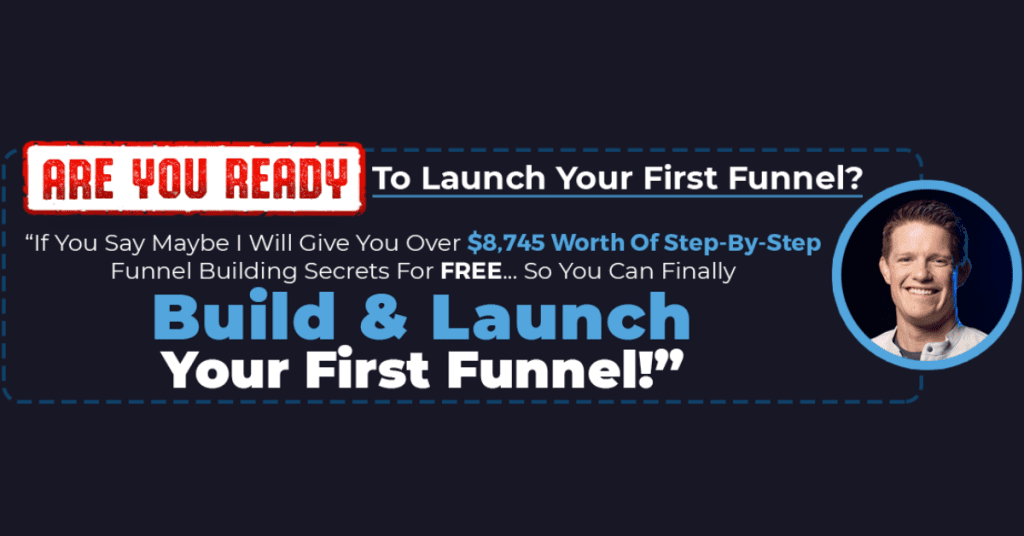Event marketing is a powerful strategy that can elevate your brand, engage your audience, and drive significant business results. In today’s digital age, where virtual interactions often dominate, hosting and promoting events can create a tangible and memorable connection with your target audience. Whether you’re orchestrating a virtual conference, a captivating in-person event or navigating hybrid events, the potential to forge meaningful connections and elevate your brand is unparalleled.
This comprehensive guide will provide you with the insights and strategies to crush it with event marketing. In this guide, we will share the strategies for organizing a successful event from setting clear objectives that align with your brand’s vision to identifying and captivating your target audience, each facet of event marketing is explored with precision.
We’ll navigate the intricacies of choosing the right type of event for your goals, showcasing the power of both virtual and in-person experiences, as well as the emerging potential of hybrid models. As we progress, you’ll discover the importance of meticulous planning and organization, the art of crafting compelling event branding and messaging, and the seamless execution made possible through leveraging cutting-edge technology.
Understanding the Power of Event Marketing
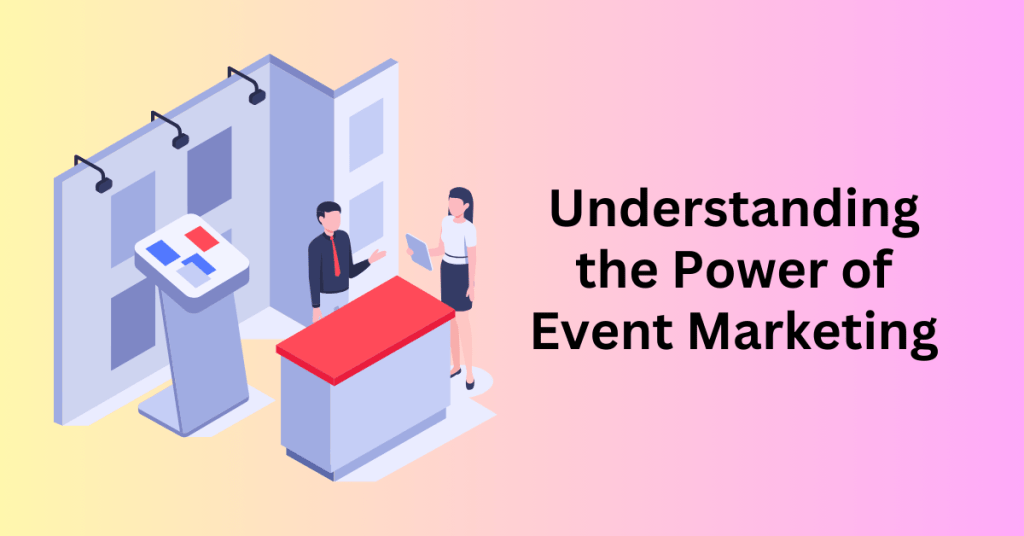
Event marketing goes beyond traditional advertising methods, providing a unique opportunity to create real-world connections with potential customers. The essence of this strategy lies in the ability to engage people on a personal level, fostering a sense of community and loyalty.
Events can take various forms, from virtual webinars and conferences to in-person trade shows and product launches. By bringing people together, whether physically or virtually, brands can establish a tangible presence in the minds of their target audience.
The significance of event marketing is also reflected in its ability to generate authentic experiences. In an era where digital interactions often dominate, events offer a chance for face-to-face engagement. This will enable you to showcase your personality, values, and products in a more immersive way.
Attendees are not just passive consumers. Instead, they become active participants, interacting with the brand, asking questions, and experiencing its offerings firsthand. This personal connection is invaluable, as it creates a lasting impression that extends well beyond the event itself.
In essence, event marketing is a powerful tool for building relationships and fostering a sense of brand loyalty that can lead to long-term customer retention.
Events provide a platform for showcasing expertise and thought leadership. Whether through keynote speakers, panel discussions, or interactive workshops, brands can position themselves as industry leaders and experts in their field. This not only enhances brand credibility but also attracts a more engaged and informed audience.
The power of event marketing lies in its ability to go beyond the digital noise. This will allow brands to cut through the clutter and make a memorable impact on their target demographic. In summary, by understanding and harnessing the power of event marketing, businesses can create meaningful connections, showcase their brand in an authentic light, and position themselves as leaders in their industry.
Setting Clear Objectives: The Foundation of Successful Event Marketing
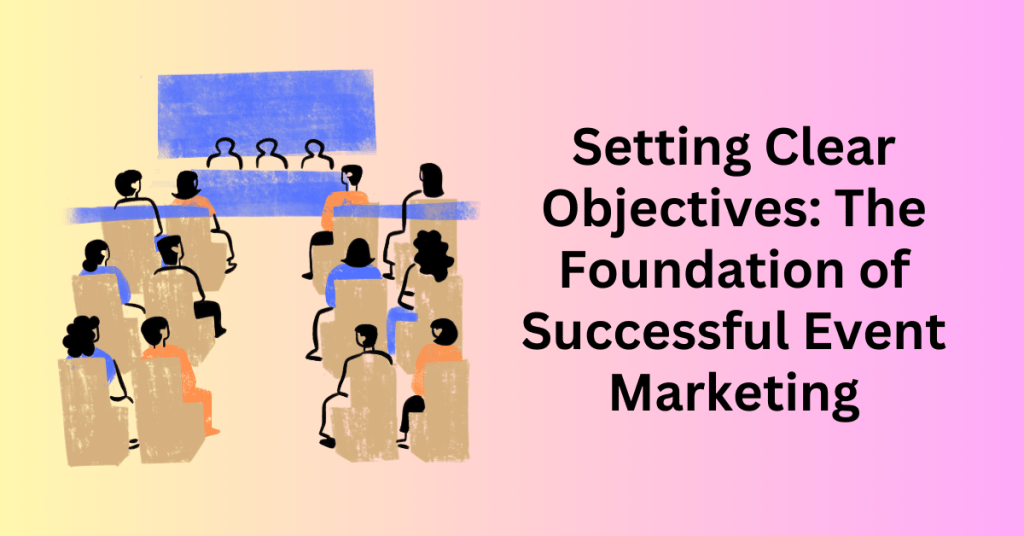
Setting clear objectives is the cornerstone of a successful event marketing campaign. Before diving into the details, it’s essential to define what you want to achieve with your event.
These objectives should be specific, measurable, achievable, relevant, and time-bound (SMART). Whether the goal is to increase brand awareness, generate leads, drive sales, or foster customer loyalty, having well-defined objectives serves as a roadmap for the entire event planning process. Clear objectives provide a focal point for decision-making, ensuring that every aspect of the event contributes to the overall success.
By having a clear goal for your event, you can amplify the impact of your event marketing efforts. For example, your marketing goal can be to expand market share among a specific demographic. So, the event can be tailored to attract and engage that target audience. This alignment not only enhances the effectiveness of the event but also contributes to a cohesive and integrated marketing strategy.
Measuring success is impossible without well-established objectives. Key Performance Indicators (KPIs) should be identified in the planning phase to evaluate the event’s performance against the set objectives. Whether it’s the number of attendees, social media engagement, leads generated, or revenue earned, having measurable metrics allows businesses to gauge the return on investment (ROI) and assess the overall impact of their event. You need to set clear objectives to provide a benchmark for success.
Also, facilitates post-event analysis, enabling organizations to learn from their experiences and continuously improve their event marketing strategies for the future. In essence, setting clear objectives is not just a preliminary step. Instead, it’s the foundation that supports the entire structure of successful event marketing.
Identifying Your Target Audience – Event Marketing
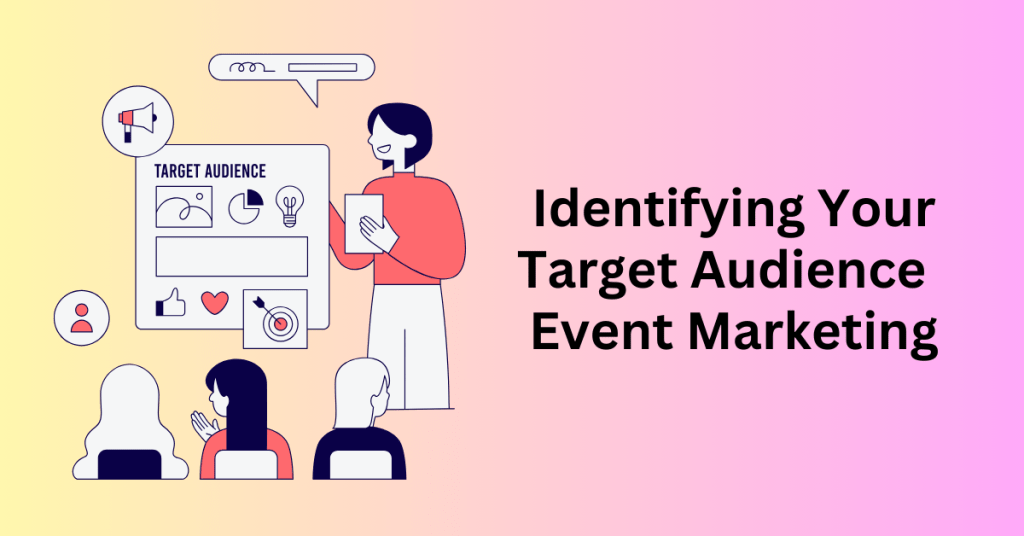
Identifying your target audience is a pivotal step in the event marketing process. This will lay the groundwork for a successful and targeted campaign. Creating detailed buyer personas is an effective strategy for understanding the demographics, interests, and behaviours of the individuals you aim to reach with your event.
These personas serve as fictional representations of your ideal attendees. It encompasses factors such as age, gender, occupation, preferences, and pain points. The more comprehensive and accurate your buyer personas, the better you can tailor your event to meet the specific needs and expectations of your target audience.
When you tailor your events, you can then use the language that they can resonate better. This will involve understanding the unique characteristics and preferences of your audience segments. For instance, a technology conference targeting industry professionals may require a different approach than a consumer-focused product launch event.
By analyzing data and leveraging market research, businesses can gain valuable insights into the preferences and behaviours of their target audience. This data-driven approach allows for the creation of events that resonate with attendees on a personal level, fostering a stronger connection between the brand and its audience.
In the digital age, data analytics plays a crucial role in refining the identification of target audiences. Utilizing tools such as website analytics, social media insights, and customer relationship management (CRM) systems can provide valuable information about the online behaviour of potential attendees.
This data can be used to fine-tune marketing strategies, personalize communication, and optimize the overall event experience. Ultimately, by accurately identifying your target audience, you can craft a more focused and impactful event that not only attracts the right attendees but also builds meaningful connections that extend beyond the event itself.
Choosing the Right Type of Event – Event Marketing
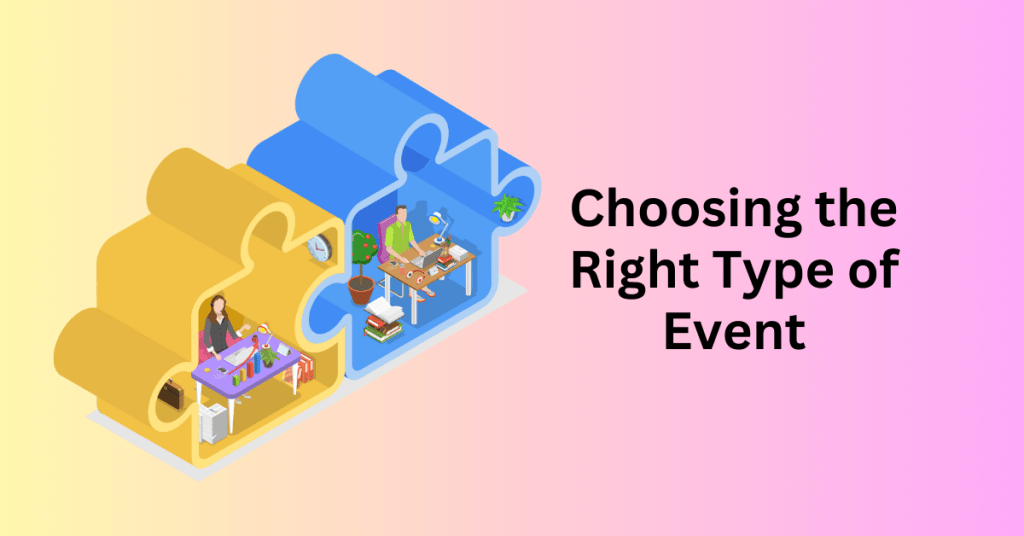
Choosing the right type of event is a critical decision that shapes the entire trajectory of your event marketing strategy. The options range from virtual events conducted entirely online to in-person gatherings that offer face-to-face interactions. The emerging trend is hybrid events, which seamlessly integrate both virtual and in-person elements. Each type has its own set of advantages and challenges. The decision should be guided by your specific goals, target audience, and the nature of your offerings.
Virtual events have gained prominence, especially in response to global events that limit in-person gatherings. They eliminate geographical constraints, allowing participants from around the world to engage with your brand. Virtual events often require less investment in terms of venue, travel, and accommodation, making them cost-effective. However, ensuring audience engagement in a digital environment is a key challenge.
In-person events, on the other hand, provide tangible, immersive experiences, fostering personal connections that are often hard to replicate virtually. The atmosphere of an in-person event can create a lasting impression, but logistical challenges and expenses can be higher.
Hybrid events combine the best of both worlds. It offers the flexibility of virtual experiences and the tangible benefits of in-person interactions. This approach accommodates diverse audience preferences and circumstances. Attendees can choose to participate in person or virtually, providing a broader reach without sacrificing the depth of engagement.
However, successfully executing a hybrid event requires careful planning to seamlessly integrate the virtual and physical components. In essence, choosing the right type of event hinges on understanding your audience’s preferences, the nature of your content, and the goals you aim to achieve. Each format presents unique opportunities, and the decision should align with your overall event marketing strategy.
Planning and Organization – Event Marketing
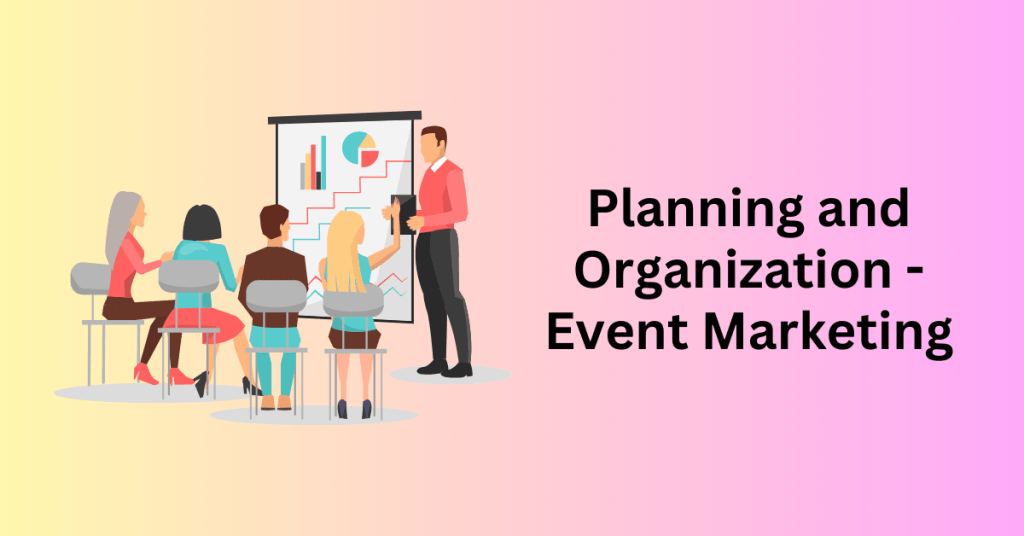
Planning and organization are the bedrock of a successful event marketing campaign. It will serve as the roadmap that guides every aspect of the process. A well-thought-out plan can ensure that all elements of the event align with the overarching goals. Besides, it will also help mitigate potential challenges that may arise along the way.
The planning phase involves developing a comprehensive strategy that encompasses key details such as event objectives, budgeting, timeline, and resource allocation. This strategic foundation provides a clear direction for the entire team and facilitates effective decision-making throughout the event’s lifecycle.
Creating a detailed event plan involves breaking down the process into manageable components. This includes defining the event’s purpose, identifying the target audience, selecting the type of event (virtual, in-person, or hybrid), and establishing measurable goals. Budgeting is a crucial aspect of the planning phase. It encompasses venue costs, marketing expenses, technology requirements, and any additional resources needed. A well-organized budget ensures that financial resources are allocated efficiently. Thus, preventing overspending and enabling a more accurate assessment of return on investment (ROI).
Establishing a realistic timeline and setting milestones are essential components of effective event planning. Timelines provide a structured overview of tasks and deadlines. It will allow for efficient coordination among team members. Milestones serve as checkpoints, ensuring that the event is progressing according to plan.
This proactive approach enables teams to identify potential issues early on and make necessary adjustments. In essence, planning and organization act as the guiding principles that transform event ideas into actionable strategies. This will ensure that every detail is considered and contributes to the overall success of the event marketing campaign.
Crafting a Compelling Event Branding and Messaging – Event Marketing

Crafting a compelling event branding and messaging strategy is a pivotal element of event marketing that sets the tone for how your audience perceives and engages with your event. The branding of your event is more than just a logo. Instead, it’s the visual and thematic representation of your event’s identity. Start by developing a consistent theme that aligns with your brand and resonates with your target audience.
This theme should be reflected in all aspects of your event, from promotional materials to the event space itself. A cohesive and visually appealing brand identity builds anticipation and recognition, making your event stand out in a crowded marketplace.
The messaging associated with your event is equally crucial. It should convey the value proposition of attending, answering the fundamental question: Why should people participate?
You need to craft a compelling narrative, a bait that communicates the unique selling points of your event. It will highlight what attendees will gain and experience. Your messaging should not only be informative but also emotionally resonant, tapping into the aspirations, needs, or desires of your target audience. Whether it’s through taglines, promotional content, or social media posts, consistency in messaging builds a unified brand voice that reinforces the overall identity of your event.
Additionally, leverage storytelling techniques to create a narrative that engages your audience before, during, and after the event. The goal is to create a lasting impression that extends beyond the event itself. Thus, fostering a connection that encourages attendees to become advocates for your brand. In summary, crafting a compelling event branding and messaging strategy is about creating a memorable identity that resonates with your audience and entices them to be a part of an experience they won’t forget.
Marketing Your Event
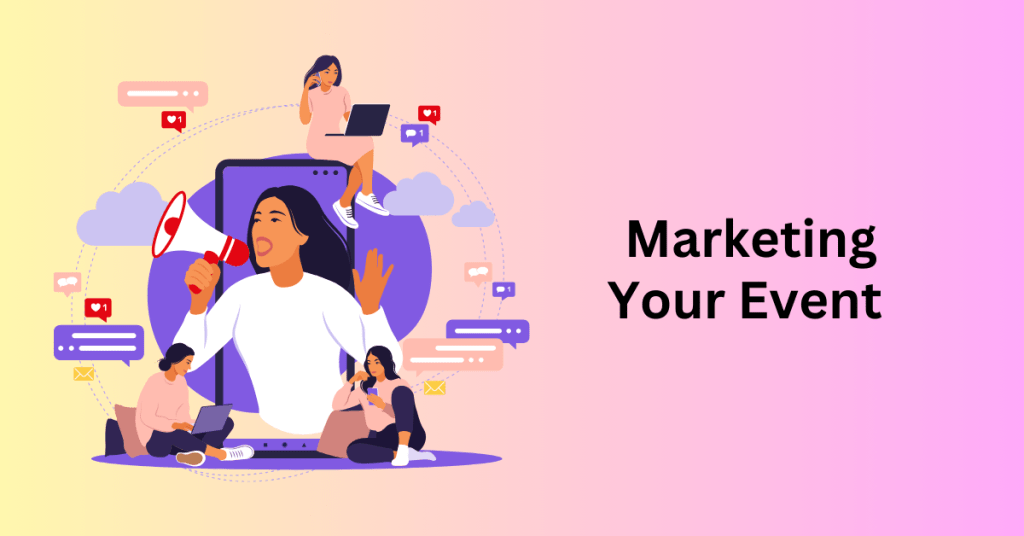
The key to a successful event is to have enough audiences to participate in your event. Firstly, you need to get your event out in the eyes of your target customers. Be it social media, emails or paid ads, you need to create a bait to hook them to get to know more about your event and get the ticket for your event.
A good bait can include your feature speaker, exclusive content, networking opportunities or freebies. Something unique that people will need to pay for and you are now offering it at a fractional cost. Sometimes, an event can be even free. You can give the event out for free just to get more potential leads and customers to join the event. This is so that you can upsell them your real high-value offer.
Building a Landing Page and Sales Funnel To Sell Your Tickets
Building a compelling landing page and an effective sales funnel is a critical step in successfully selling event tickets. The landing page serves as the digital storefront for your event, capturing the attention of potential attendees and compelling them to take action.
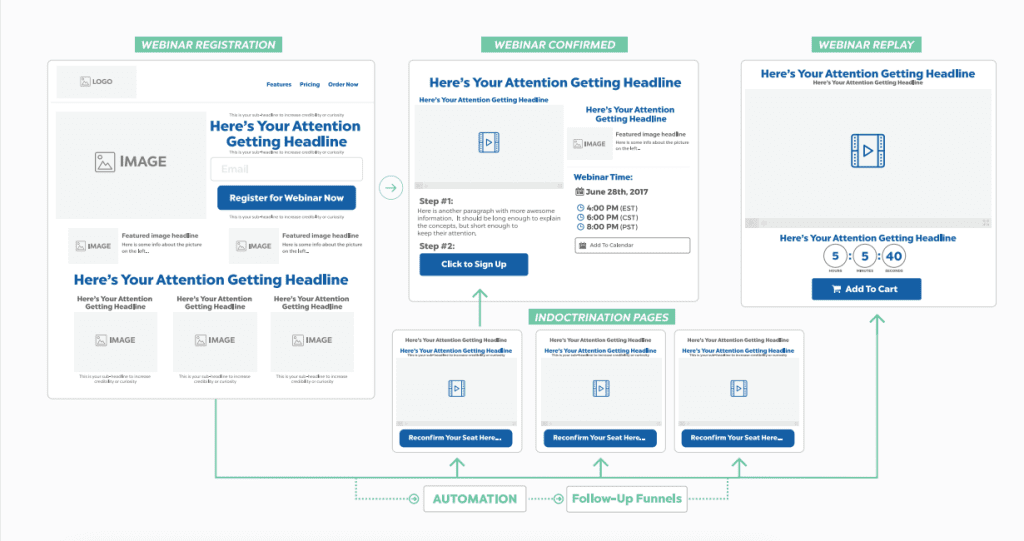
A visually appealing, easy-to-navigate page with engaging content and clear calls to action can significantly impact conversion rates. You can incorporate elements that convey the unique value proposition of your event. This will include captivating visuals, concise event details, and persuasive copy that highlights the benefits of attendance. Also, ensure that the registration or ticket purchase process is seamless and user-friendly. This will reduce friction and encourage visitors to commit to attending your event.
The sales funnel for event ticket sales is essentially the journey a potential attendee takes from the moment they land on your page to the point of completing a ticket purchase. Start by creating awareness through various channels such as social media, email marketing, and online advertisements. Once potential attendees arrive at your landing page, strategically guide them through the decision-making process.
You can do it by utilizing persuasive elements like testimonials, early-bird discounts, or limited-time offers to create a sense of urgency. Besides, you may also consider implementing a two-step checkout process to gather essential information without overwhelming the user. The first step will focus on collecting their contact details. This is so that if they do not complete the purchase now, you can still follow up.
Additionally, incorporating retargeting strategies can help re-engage individuals who visited the page but did not complete a purchase. This can provide a second chance to convert interested leads into attendees.
Optimization and A/B Testing
For your landing page and sales funnel, you need to analyze the performance and optimize it to increase the conversion rate. For example, you may implement tracking tools like Google Analytics to monitor user behaviour, conversion rates, and other relevant metrics. Besides, A/B tests different elements of your landing page. This includes headlines, imagery, or call-to-action buttons to provide valuable insights into what resonates best with your audience. By continually refining your landing page and sales funnel, you can enhance the user experience, and increase conversion rates.
Building Hype and Excitement: Pre-Event Marketing Strategies

Building hype and excitement through effective pre-event marketing strategies is crucial for ensuring a successful turnout and engagement during the actual event. A well-executed pre-event marketing campaign generates anticipation, sparks curiosity, and motivates potential attendees to mark their calendars. Social media platforms play a central role in building this excitement.
You can leverage the power of platforms like Facebook, Instagram, Twitter, and LinkedIn to create engaging content, teasers, countdowns, and event highlights. Depending on the nature of your event and where your target audiences are, you may choose the right platform that works best. These platforms provide a direct line of communication with the target audience. It will enable you to share sneak peeks, behind-the-scenes content, and important event updates, fostering community and anticipation. It’s like a movie trailer before the release.
Email marketing is another potent tool for pre-event promotion. Crafting compelling and personalized email campaigns can reach a broader audience and provide detailed information about the event, including speakers, agenda, and exclusive offers.
Besides, you can utilize segmented email lists for targeted messaging that resonates with specific audience segments. Countdown emails, early-bird promotions, and exclusive pre-event content can create a sense of urgency and exclusivity. It will drive early registrations and build momentum leading up to the event.
Finally, influencer partnerships are increasingly popular in pre-event marketing strategies. Collaborating with influencers relevant to your industry or target audience can exponentially expand your event’s reach. Influencers can create buzz through sponsored content, live streams, or testimonials, lending credibility and authenticity to your event. Contests and giveaways tied to the event can also generate excitement and encourage social media sharing. This will create a ripple effect as participants share their anticipation with their networks.
Post-Event Follow-Up and Analysis

Post-event follow-up and analysis are crucial phases in the event marketing cycle that often determine the long-term impact of your efforts. Collecting feedback and testimonials from attendees is a fundamental step in gauging the success of your event.
You can utilize surveys, post-event emails, or social media polls to gather insights into attendee satisfaction, identify areas for improvement, and understand what aspects resonated the most with your audience. This feedback not only provides valuable qualitative data but also helps in shaping future events.
Analyzing event performance involves assessing quantitative metrics to measure the return on investment (ROI) and overall success. Key Performance Indicators (KPIs) may include the number of attendees, engagement levels, leads generated, conversion rates, and revenue earned. Analytical tools and event management platforms can provide detailed reports on these metrics, offering a comprehensive overview of your event’s impact. By comparing actual results against the predetermined objectives set during the planning phase, you can identify areas of achievement and areas for improvement.
Post-event Communication
Post-event communication is an integral part of the follow-up process. You need to first express gratitude to attendees. This can be done through personalized emails, acknowledging their participation and emphasizing the value they brought to the event. Then, share highlights, photos, and key takeaways through various channels. This includes social media and newsletters, to keep the momentum going and extend the event’s reach beyond its immediate conclusion.
Additionally, you can leverage the post-event period to nurture leads and connections made during the event. Then, continue the conversation and potentially convert leads into customers. In essence, the post-event follow-up and analysis phase is not only about evaluating past performance. Instead, it’s also about building on the success of your event to foster ongoing engagement and refine your event marketing strategy for future endeavours.
How To Build The Event Registration Page
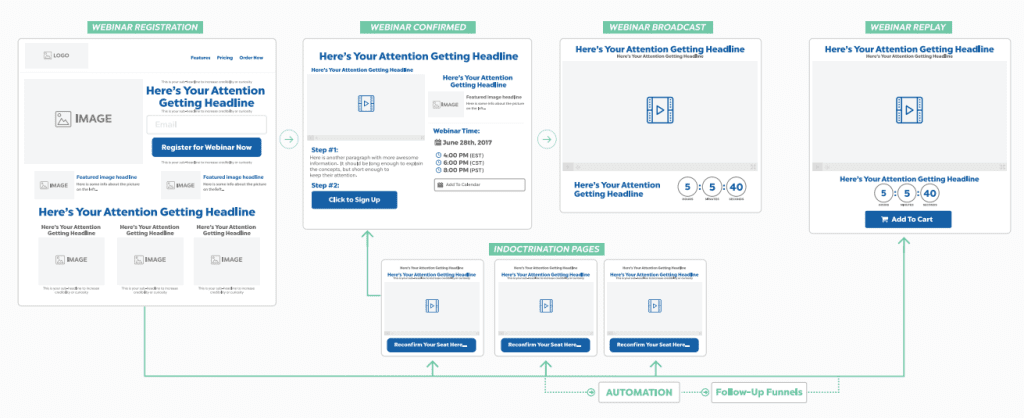
The most important for an event is to sell enough tickets for it. Hence, other than your perfect webinar script, your webinar registration page is the most important.
1. Attention-Grabbing Headline
In every landing page, an eye-catching headline is the most important. It is the deciding factor whether someone continues reading your page or not.
It should be specific and able to hook your target customers to continue and look forward to reading more about the details.
In your headline, you can have something that is exciting for them but doesn’t overkill by overpromising. Doing this will let them think that your offer is a scam.
2. Short Explanatory Video
In your webinar registration page, it is good to have a video on your page.
A video will make it easier for your target audience to listen and know about you. This is very powerful compared to a sales copy and a photo. Now they are hearing your voice and your pitch.
Sales pages with videos typically have more engagement than sales pages without videos. So this is a simple way to increase time-on-page and even conversion rates.
In the video, you can start with a question about how your product will help them to resolve a problem within a specific timeframe. And that is exactly what they are looking for. Something that they had tried different products, but were unable to solve.
The goal here is to create an open loop in their mind about what you can do and solve for them. And the details or the solution will be explained in the webinar.
Video Script Example
For example, if you are serving a real estate agent, you can start with “Do you know how you can get unlimited new prospects that are actively looking for properties in 30 days without cold calling? Imagine that you can have a virtual salesperson who is promoting your business and collecting new leads for you 24/7. And all you need to do is to follow up with the potential customers and close them”
In order for them to know more about the solution that you are having, they will sign up for your webinar.
This is a good way to create curiosity in your sales page and to get them to join your webinar.
After you have built the curiosity, you can now explain your background to build some authority on why they should listen to you. What have you achieved or what is your skill for them?
3. Using Bullets
Bullets are very useful to let people know exactly why they need to join the webinar and what they can expect to take away from it.
You are not going to tell in each part of your webinar what you are going to teach. Instead, you share that after joining it, they will know a certain skill.
Your headline and video are doing great to hook them to stay on your page. But the bullet points are the ones that give them the justification they need to complete the purchase.
When you make a promise with your bullet points, you are telling them exactly what they can expect from the webinar. And if they think it’s not a good fit for them, they can just leave. https://bennietay.com/go/perfect-webinar/Otherwise the right customers will definitely sign up for it.
Perfect Webinar Secrets – The Framework of Successful Event Hosting
Final Thoughts: The Complete Guide To Master Event Marketing
From setting clear objectives to creating compelling event branding, and from leveraging technology for seamless execution to engaging attendees with dynamic experiences, each facet contributes to the success of your event. The power of event marketing lies not just in the event itself but in the lasting impression it leaves on your audience.
As you embark on your event marketing endeavours, don’t forget the importance of planning, adaptability, and continuous improvement. Events are dynamic, and staying attuned to the evolving landscape ensures that your strategies remain fresh, relevant, and impactful. The post-event follow-up and analysis phase is your opportunity to refine your approach, incorporating lessons learned and insights gained to shape future successes.
In a world saturated with digital noise, events stand as beacons of tangible connection. They have the potential to transform your brand from a logo on a screen to a vivid memory in the minds of your audience. We encourage you to take the lessons learned here and apply them with creativity, enthusiasm, and a commitment to excellence. Whether you’re orchestrating a virtual summit, hosting an in-person extravaganza, or navigating the hybrid landscape, use this guide as your compass.
